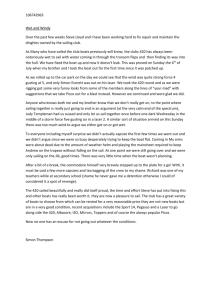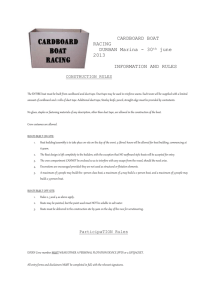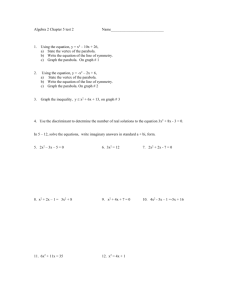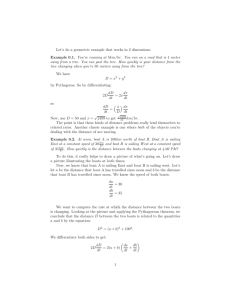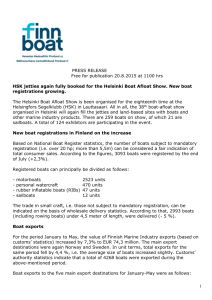DERELICT BOATS IN DOG RIVER, ALABAMA Tela V. O’Rourke
advertisement
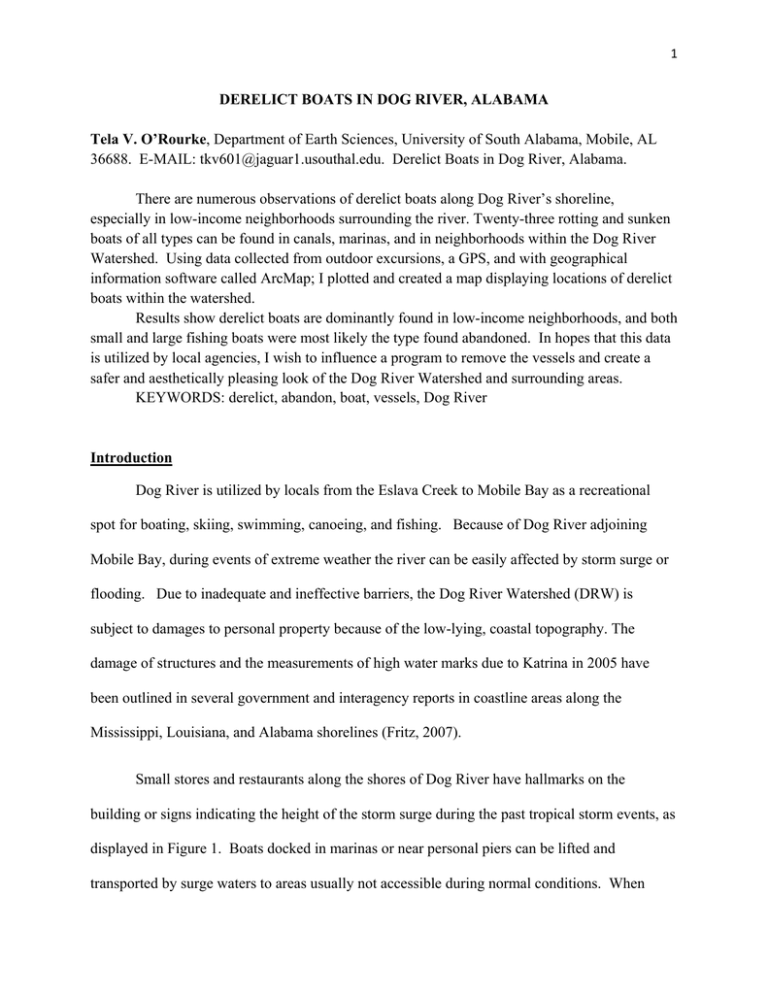
1 DERELICT BOATS IN DOG RIVER, ALABAMA Tela V. O’Rourke, Department of Earth Sciences, University of South Alabama, Mobile, AL 36688. E-MAIL: tkv601@jaguar1.usouthal.edu. Derelict Boats in Dog River, Alabama. There are numerous observations of derelict boats along Dog River’s shoreline, especially in low-income neighborhoods surrounding the river. Twenty-three rotting and sunken boats of all types can be found in canals, marinas, and in neighborhoods within the Dog River Watershed. Using data collected from outdoor excursions, a GPS, and with geographical information software called ArcMap; I plotted and created a map displaying locations of derelict boats within the watershed. Results show derelict boats are dominantly found in low-income neighborhoods, and both small and large fishing boats were most likely the type found abandoned. In hopes that this data is utilized by local agencies, I wish to influence a program to remove the vessels and create a safer and aesthetically pleasing look of the Dog River Watershed and surrounding areas. KEYWORDS: derelict, abandon, boat, vessels, Dog River Introduction Dog River is utilized by locals from the Eslava Creek to Mobile Bay as a recreational spot for boating, skiing, swimming, canoeing, and fishing. Because of Dog River adjoining Mobile Bay, during events of extreme weather the river can be easily affected by storm surge or flooding. Due to inadequate and ineffective barriers, the Dog River Watershed (DRW) is subject to damages to personal property because of the low-lying, coastal topography. The damage of structures and the measurements of high water marks due to Katrina in 2005 have been outlined in several government and interagency reports in coastline areas along the Mississippi, Louisiana, and Alabama shorelines (Fritz, 2007). Small stores and restaurants along the shores of Dog River have hallmarks on the building or signs indicating the height of the storm surge during the past tropical storm events, as displayed in Figure 1. Boats docked in marinas or near personal piers can be lifted and transported by surge waters to areas usually not accessible during normal conditions. When 2 waters recede, boats left behind serve as a hazard and an eyesore to residents and others who boat and fish along the river. Abandoned boats are defined as “if the vessel is located for either a period of more than thirty consecutive days, ‘in the same area’ within a radius of five miles of any location where the vessel was previously moored or anchored, has been left on private property without authorization of the owner, or is sunk or in danger of sinking, is obstructing a waterway, or is endangering life or property while on aquatic lands” (Derelict Vessel Removal Program, 2012). Figure 1. Donald Brinkman, who stands at 6’1”, here at the Grand Mariner off of Dog River indicates the height of storm surge during past tropical storm events. The bottom circle is the storm surge height of H. Georges in 1998, which peaked at 12ft above sea level. The top circle is H. Katrina in 2005, where the storm surge reached 16ft above sea level in this area. Driving down Dauphin Island Parkway, an onlooker can see multiple abandoned crafts along the shorelines and sand bars on the edge of Dog River. For many of the boats considered abandoned, the owner is unknown. Eyesores as shown in Figure 2 show two boats abandoned by owners and left to rot in canals evidently visible from Dauphin Island Parkway (DIP). Through 3 my research, I have found no regulations concerning removing sunken vessels from the river, nor have I collected data on how long the watercrafts have been in that area. Some of the boats found are in small canals and create difficulties when trying to navigate around them. Figure 2. Two abandoned boats lie in a canal located directly off of Dauphin Island Parkway. Plant growth and birds’ nests on the crafts indicate the lengthy time the derelict boats have rested here. The combination of swimming, water-skiing, and boating during the summer months can be deadly if you are unaware of your surroundings. In fact, when people were asked, “Estimate how many people are likely to die in the U.S. next year (if the next year is without catastrophe) including consequence of 30 actions or technologies”; boating was ranked one of the lowest (Slovic 1984). The EPA recognizes the second highest (30.9%) type of damage caused to a boat or property were influenced by hazards or people in the water or something else outside the boat (NRBR 2003). Hazards like a natural disaster can cause severe damage to a boat or craft, if struck hard enough or transported to a place where it cannot be removed. Boating risks change with the seasons. During the summer months, boating incidents are more pronounced due increased use of watercrafts during warmer temperatures (Murphy 1983). Tourism increases during Mobile’s long summer months. With nearby beaches and local festivals that occur between May and October, tourism becomes a necessity for many local businesses. If tourists were to drive down DIP, the closer the viewer gets to the bridge and marina, they will see derelict boats on the either side of the road. A motorist will pass four 4 vessels along the road within a half-mile strip of the parkway. Many visitors use DIP as a main route to Dauphin Island. The sight of so many derelict boats can cause a bad impression of our beautiful coastlines in Mobile and in Alabama. Research Question Where are the abandoned boats in Dog River located? In what areas are they most frequently located? What are the most common type craft found abandon? The research found in this report provides the Dog River community with a collection of sightings and observations of known locations of abandoned water vessels within the river and its tributaries. Methods Through the help of fellow classmates and a personal motor boat, I navigated around Dog River and the surrounding canals and tributaries. Utilizing a global positioning system (GPS), I plotted occurrences of any type of sunken water vessel within the Dog River Watershed. In my field notes, I indicate the location of that particular boat by latitude and longitude, type and size of the vessel, date and time of occurrence, and the condition of the craft at that given state. Using the field work data, I created a raster on geographical information software (GIS) called ArcMap to show the density of boats in certain areas of the river and what area-type is the craft found (low income neighborhoods, high income neighborhoods, marsh, marina, or canal). In Excel, I manufactured pie charts showing location of derelict boats and the type of derelict boats found. Raw data shown in the Appendix of this report give details of the data collected in my fieldwork. 5 Figure 3. The vessels above are located near the mouth of Eslava Creek. An old yacht and burned pontoon boat are left neglected in this low‐income Results From the data collected, I was able to determine the locations of derelict boats on Dog River and where the density of abandoned boats is the highest. Two locations were substantially higher than other areas. The map above (Figure 3) shows the density of boat locations along my reconnaissance of Dog River. The area in red at the top of the map is located in a low-income neighborhood. Within a 1500ft radius, there were seven derelict boats in the location. Another area with a high density of derelict boats was around the marinas close to Dauphin Island Parkway. This location, six derelict boats were found within 1500ft, and nine within 3000ft. 6 The boats abandoned were in the marina or in small canals. All had the appearance of years of decay and neglect. An example of boat conditions can be seen in Figure 2. Decaying boats create homes for birds’ nest and plant life when neglected in an area for a long period without use. The most common type of craft found throughout the entire Dog River area where both small and large fishing boats left on the shoreline of docks or stuck in the marsh. Marinas and canals made up nearly 32% of boats found neglected, not to include canals in areas of lowincome neighborhoods. Watercrafts in small water alleyways and near shorelines in residential neighborhoods are safety hazards to people who intend to use the river as a recreational source. Areas of tight canals and tributaries, derelict boats become obstacles to avoid or navigate around. In shallow waters throughout Dog River, this can create boating accidents and cause personal injury to the people involved. Throughout my reconnaissance of Dog River, twenty-three derelict water vessels were found in total. Figure 4. Pie chart indicated location of derelict boats Figure 5. Pie chart indicates type of derelict boats found 7 Conclusion Areas considered lower-income neighborhoods had a higher occurrence of derelict boats. Both high-density areas were located in those types of communities. My hypothesis of the observation is that residents in this type of community seldom possessed homes in a good standing condition. If those residents cannot concern themselves with the up-keep of their home, removing an unsightly sunken or rotting boat nearby may not a priority to them. Another theory is perhaps the resident would like to remove the vessel, but simply cannot afford to do so. Derelict boats found in canals and marinas, the question of ‘who is responsible for the removal of the abandoned boats’ comes into play. Is it the owner who fronts the cost for the boat removal? Or is it through the marina management, or is it the state or city’s responsibility? In Washington State, contractors are paid through the Environment Protection Agency (EPA) and the United States Department of Agriculture (USDA) to remove derelict boats if the owners will not (Derelict Vessel Removal Program, 2012). Programs like this are available in the Dog River area, but only after large natural disaster events. The locations I have plotted through my research were just of the boats that were in the most obvious locations. Of the twenty-three discovered, there are many more left unseen. This is not to include boats completely submerged under water. In a study conducted on the tourism and environmental regulations, a location that is not environmentally responsible to the local habitat, can severely hurt tourism in the location; thus affecting the economy for that region (Forsyth 1997). Regulations need to be set in the Dog River area to enforce management of abandoned water vessels. Utilizing the data collected from my research as a tool, agencies such as the Dog River Clearwater Revival can emphasize the 8 number of neglected vessels, areas vessels are located, and the density in those areas to start a program that will remove the potential hazards the abandoned boats create. With the average costs of the removal process estimated is an average of $ 8,000 to $ 10,000 per vessel, costs fall to one of several governmental bodies and, therefore, the taxpayers (Brailsford, 2011). Usually due to the owners of the vessels are often unidentifiable. Remove the derelict and abandoned boats, and improve and protect the environment of the Dog River Watershed. That should be a mission; that should be a goal. References Cited Brailsford, Susanna. “Abandon Ship! Legal Approaches to South Carolin’s Derelict – Vessel Problem.” South Carolina Law review, Vol. 62. Pages 587-606. (2011) “Derelict Vessel Removal Program” Aquatic Resources Program Policy Unit. (Oct., 2003). Web. (Accessed March 1, 2012) http://www.dnr.wa.gov/recreationeducation/topics/derelictvessels/pages/aqr_derelict_ves sel_removal_program.aspx Forsyth, Timothy. “Environmental Responsibility and Business Regulation: the case of sustainable tourism”. The Geographical Journal. Vol. 163. No. 3. NOV. (1997) Fritz, Hermann, Chris Blount, Robert Sokoloski, Justin Singleton, Andrew Fuggle, Brian McAdoo, Andrew Moore, Chad Grass, and Banks Tate. “Hurricane Katrina Storm Surge Distribution and Field Observations on the Mississippi Barrier Islands”. Estuarine, Coastal, and Shelf Science. Vol. 74, Iss. 1-2, Pages 12-20, (August 2007) Murphy K.J. and J. W. Eaton. “Effects of Pleasure-Boat Traffic on Macrophyte Growth in Canals”. Journal of Applied Ecology. Vol. 20, No. 3 pages. 713-729. (Dec., 1983) (NRBR) “2002 National Recreational Boating Survey Report” Strategic Research Group. Page 113. (Nov., 2003) Web. (Accessed March 1, 2012) http://www.uscgboating.org/assets/1/Publications/ USCG_NRBS%202002-Report.pdf Slovic, Paul and Baruch Fischhoff. “Modeling the Societal Impact of Fatal Accidents.” Management Science , Vol. 30, No. 4, Risk Analysis pages 464-474. (Apr., 1984) 9 APPENDIX: Raw Data Latitude N Longitude W Boat Type 30.57268 -88.13667 Large boat 30.63203 30.577906 30.571794 -88.09638 -88.085639 -88.086033 30.579694 -88.083628 30.579695 -88.083628 Pontoon Boat Yacht large boat small fishing boat Small Fishing Boat 30.556042 -88.108506 Large Boat 30.63202 30.577906 30.577906 -88.09628 -88.085639 -88.085639 30.575081 30.583569 -88.091642 -88.0764 30.579694 -88.083692 Yacht Large Boat Yacht small fishing boat canoe Small Fishing Boat 30.63223 -88.09448 Large Boat 30.63167 -88.09662 large boat 30.607289 -88.102286 30.63395 -88.09358 30.64135 -88.09743 sailboat Barge/dredging boat Barge/dredging boat 30.6066 -88.13568 canoe 30.64175 -88.098842 30.63395 -88.09358 30.63198 -88.09427 sailboat small fishing boat small fishing boat Location Found Condition Area high income neighborhood low income neighborhood marina canal burned Rabbit Creek burned burned decaying canal Marina canal/dip canal decaying canal canal high income neighborhood low income neighborhood marina marina decaying decaying canal/dip Dog River/ Scenic Drive decaying decaying decaying canal Marina marina Marsh marsh decaying rotting Dog River Perch Creek canal low income neighborhood low income neighborhood low income neighborhood low income neighborhood low income neighborhood low income neighborhood low income neighborhood low income neighborhood rotting/sunken rotting/sunken canal Rattle Snake Bayou rotting/sunken canal rotting/sunken Canal/Riverside Dr rusting tributary sunken Eslava Creek sunken Alligator Bayou sunken Eslava Creek sunken tributary Marsh sunken Dog River *Excel chart showing field note data of derelict boats found in Dog River Watershed 10 Location Number Percentage marina Marsh canal high income neighborhood low income neighborhood 3 of 22 3 of 22 4 of 22 13.64 13.64 18.18 2 of 22 9.09 10 of 22 45.45 *Location Type and Percentage for derelict boats found Boat Type Number Percentage Large boat Canoe barge/Dredging Boat Yacht Small Fishing Boat Sail boat Pontoon Boat 6 of 22 2 of 22 27.27 9.09 2 of 22 3 of 22 6 of 22 2 of 22 1 of 22 9.09 13.64 27.27 9.09 4.55 *Boat type and percentage for derelict boats found Condition Number Percentage Burned Decaying Rotting Rotting/Sunken Rusting Sunken 3 of 22 8 of 22 1 of 22 4 of 22 1 of 22 5 of 22 13.64 36.36 4.55 18.18 4.55 22.73 *Condition and percentage of derelict boats found


